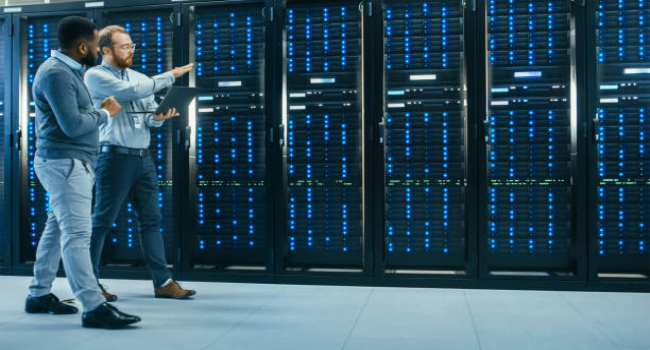
Securing Data Centers from the Inside Out
- By Matt Strautman
- Sep 06, 2022
By the end of 2013, the world’s datasphere had grown to approximately 4.3 zettabytes large. By 2018, as artificial intelligence, smart devices, streaming services, cryptocurrency, 4G and other data-heavy applications exploded—the size of the world’s datasphere swelled sevenfold to 33 zettabytes. Come 2025, the International Data Corporation (IDC) predicts the world’s datasphere to swell to 175 zettabytes.
Suffice it to say; Data, today, is the most valuable resource in the world.
The Importance of Data Center Security
For this reason, data centers—the entities that centralize the world’s data storage, processing and dissemination across organizations—represent some of the most important facilities among those categorized as critical infrastructure to secure. Because individual data center clusters can house up to 1 exabyte (or 1 billion gigabytes) of data, they must be protected at all costs.
Not only against potential intruders, seeking to bypass a physical perimeter to sabotage a facility, but also from preventable problems like an overheated server or a power outage.
For this reason, today’s security, asset protection, and preventative maintenance for data centers must account for everything from beyond the perimeter to within each individual server cabinet.
Common Pain Points
Simply put, data centers cannot afford to take physical security and asset monitoring lightly. Accomplishing both, however, is not a simple task. There are two significant pain points data centers face daily:
1. Data center clusters are often kept within massive, remote facilities with expansive perimeters, meaning the threat of a bad actor attempting to break into a facility to access a network and sabotage data remains constant. On top of this, half of the respondents to Data Center World’s “2020 State of the Data Center Report” noted that the biggest security concerns for their facilities derive from outside human threats.
2. There is the threat of unplanned outages and/or overheated servers, the cost of which, according to a study from the Ponemon Institute, can amount to as much as $9,000 to $17,000 per minute.
Regardless of where the pain is coming from, using advanced sensor technology can improve your detection at the perimeter and increase your operational efficiency within the building.
At the Perimeter
The best strategy for securing data centers begins with a multilayered perimeter intrusion-detection system (PIDS), which utilizes several different sensors to identify and track targets for end-to-end perimeter protection. Beyond the perimeter, a multilayered PIDS plays a key role in identifying a potential threat long before it reaches the fence line.
In fact, layering ground-based radars with rugged, multispectral cameras at the fence line allows a PIDS to detect approaching targets hundreds if not thousands of meters away, even in the most compromising environmental conditions. This powerful functionality enables data-center security staff to mitigate potential threats long before they are able to cause harm.
As potential threats approach the fence line, convolutional neural network (CNN)-based analytics enable accurate target classification. Thermal and visible images conditioned through CNN-based analytics allow for a higher degree of accuracy when needing to confirm and classify any intrusion at the perimeter.
At closer range, short-range ground radar technologies and visible, pan-tilt (PT) cameras enable real-time target tracking capabilities, once an intruder is detected and classified. When integrated using a video management software (VMS), each of these powerful solutions equip security personnel with versatile and powerful edge device integration, target tracking hand-off, forensic-quality image processing, and global administration. Together, any PIDS outfitted with these devices ensure the data center perimeter is protected from all potential threats, ground- or air-based, in all conditions.
Condition Monitoring
Securing a data center from all potential threats is not limited to perimeter protection alone, either. Within both server rooms and server cabinets, the immediate threat to data center assets is equipment failure due to overheating and/or loss of power.
To address these concerns, condition monitoring technologies, such as fixed and handheld IR thermography devices, support identifying and correcting unseen problems in a data center’s power, cooling and support systems. This includes short cycling of the air conditioning system, loose electrical connections, and worn-out bearings—long before they cause unplanned outages or undetected degradation, saving data centers both downtime costs and equipment failure.
Fixed or handheld IR technology is also purpose-built to issue instant alerts whenever asset temperatures within a server cabinet, itself, exceed set parameters. In addition to thermographic condition monitoring devices, personnel can also deploy IR Windows within server cabinets to protect personnel while inspecting them. These windows are built with broadband crystal lenses transmitting short, mid, and longwave IR, which allow illumination to shine through while also creating a barrier between personnel and energized equipment. Whether monitoring the heat levels of individual cabinets or inspecting equipment, condition monitoring technologies make asset monitoring and maintenance safer and more efficient.
The Benefits of Full System Integration
By layering powerful sensors, such as ground-based radar, multispectral fence-line cameras, video analytics, and VMS software at the perimeter, data-center security personnel can detect intruders at long range, verify those threats using thermal and visible cameras, and then distribute critical alerts, well before an event unfolds.
Within server rooms, data-center maintenance staff can use the same thermographic technology in handheld and fixed condition monitoring cameras to detect overheating equipment or asset irregularities for immediate intervention prior to system failures resulting in unplanned, costly outages—ensuring the data center is secure, inside and out.
Combining these powerful technologies under one, comprehensive system not only ensures the longevity of data center assets, but they also protect on-site personnel from outside and inside safety and security threats for years to come.